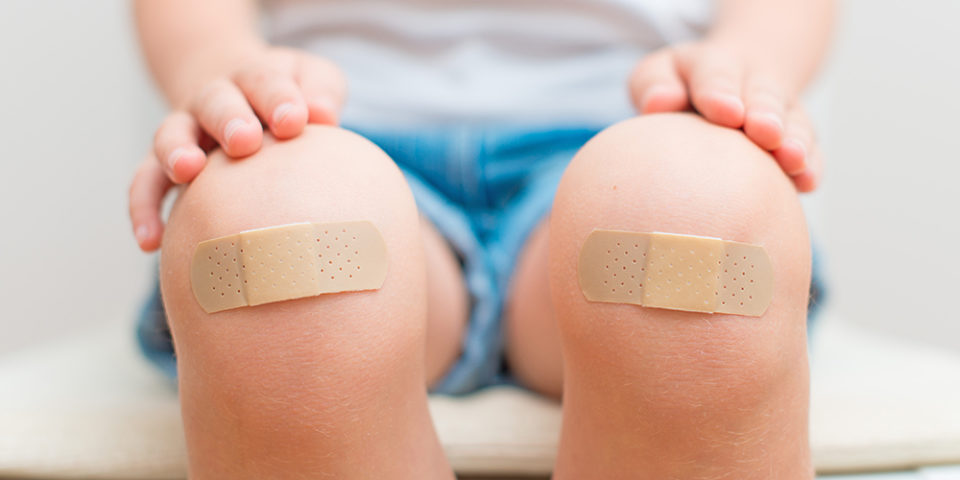10 most common injuries in children
Whether it’s on the playground or at home, bumps, bruises, bug bites and other injuries can happen to children. Josh Wyatt, MD, offered advice on prevention, first aid tips and when to seek care for the 10 most common injuries in children.
1. Bites: Mosquito, tick, spider or animal
It is no fun to experience a bite, but it happens. Some are minor, like a mosquito bite, and others may require immediate attention from a doctor, like a dog bite.
- How can you prevent bites? To prevent mosquito bites, products containing 10–30% DEET are considered the best options for children two months old and up. It can be tough to prevent tick and spider exposure, so wear long sleeves and be sure to search for bites after being outside, especially when in areas with known ticks.
- What first aid should a parent provide? For mosquito bites, applying cool compresses or 1% hydrocortisone can help symptoms. Hydrocortisone should not be applied to the face or genitals without asking your pediatrician. Oral Benadryl can also be given for children over two years old. If you find a tick attached to the skin, use tweezers to grab the head and remove the tick. Be sure to remove all of the tick.
- When should you seek care? If the redness around the bite worsens or your child starts to have a fever or any other sick symptoms, seek care. Any time the skin in broken, there is risk for a secondary skin infection. Seek care after a tick bite if a rash, fever or other sick symptoms develop. In general, if a tick is removed within 24–36 hours after the bite, there is low risk for developing a tick-borne illness. If your child sustains a dog, cat or snake bite, contact your pediatrician immediately.
2. Concussions
Concussions usually happen after some type of head trauma or injury.
- How can you prevent concussions? Accidents can happen, but proper head gear when riding a bike or playing sports can help protect those little noggins and prevent serious injury.
- What first aid should a parent provide? It is acceptable after an injury to give acetaminophen or ibuprofen (for children six months old and older) for pain. After a concussion or head injury, it is also important to allow the brain time to heal. This includes: no sports or activity until symptoms resolve, reduced screen time, adequate hydration and sleep. Talk to your child’s pediatrician for clearance on when it is okay to return to sports or other physical activities.
- When should you seek care? Concussion symptoms can include headache, nausea, vomiting, blurry vision, trouble concentrating, trouble sleeping, not feeling well, and sensitivity to light or sound. These symptoms can last a few days to weeks. You should contact your pediatrician or seek immediate care if your child has loss of consciousness after the head injury, is having confusion, is repeatedly vomiting, the headache is worsening or if your child is having any weakness, trouble walking or drowsiness. Always seek care if you have any concerns after a head injury.
3. Rash (contact dermatitis): Poison oak, poison ivy and poison sumac
When children are playing outside or helping with yard work, exposure to plants that cause itchy rashes can sometimes occur.
- How can you prevent contact dermatitis? The oil produced by poison oak, poison ivy and poison sumac can cause a rash. But if you wash the oil off within a few minutes of exposure, you could avoid the allergic response. If the oil gets on clothes, bed sheets or pets, you could continue to be exposed to the oil until it’s removed. The best prevention is to understand what the plant looks like and avoid exposure.
- What first aid should a parent provide? These rashes are extremely itchy and scratching only makes the itching worse. Cool to lukewarm baths, calamine lotion and limited 1% hydrocortisone cream can help soothe the itch.
- When should you seek care? If the rash is covering a large portion of the body, oral steroids can be a treatment option. Contact your pediatrician if the rash is on several body parts or if the skin is red or hot surrounding the rash. Red and hot symptoms could indicate a secondary infection. It is important to know that the fluid inside the blisters and the rash itself does not cause further rash spread. The plant oils cause the rash and once the oils are gone, spreading should not occur.
4. Drowning
Most childhood drowning accidents happen in home swimming pools. Children should always have direct supervision when around water.
- How can you prevent drowning accidents? Home swimming pools should have fences around the pool that are four feet tall with four sides. These fences are the most effective way to keep young children out of the pool when no one is watching. When children are swimming, they should always have adult supervision.
- When should you seek care? If a drowning incident occurs, immediately call 911.
5. Fractures
Just like other accidents, fractures can happen when children are playing.
- What first aid should a parent provide? It is acceptable after an injury to give acetaminophen or ibuprofen (for children six months old and older) for pain. Ice and immobilizing the area of injury can be helpful as well.
- When should you seek care? Skin color change, swelling, deformities or decreased use of the injured body part can be signs of an underlying fracture. Contact your pediatrician or seek urgent care if you are concerned for fracture or dislocation.
6. Gun injuries
Gun related injuries are also another common childhood injury that can end in tragedy or major trauma.
- How can you prevent gun accidents? The American Academy of Pediatrics (AAP) advises the safest home for children is one without guns. If you can’t remove firearms from your home, safe storage is of utmost importance. All guns should be locked up and unloaded. Ammunition should also be locked up and stored separately from the firearm.
- When should you seek care? If your child experiences a gun injury, seek care immediately.
7. Ingestion: Poison control, magnets, coins and other items
Small children like to put things in their mouth, which can lead to injury.
- How can you prevent ingestion injuries? Keep medications, household chemicals, coins, magnets, batteries and other items that could be ingested and cause harm out of the reach of children. All medications and household chemicals should have childproof caps or tops.
- When should you seek care?
- For medication or chemical ingestions, call poison control immediately at 1-800-222-1222. This service will direct you on what your next steps should be.
- For ingestions of magnets, sharp objects or batteries, immediately call your pediatrician or seek care.
- For ingestions of coins, toys and other small objects, call your pediatrician. You may not need to seek urgent care as observation may be an option.
8. Car injuries: Car accidents and hot cars
Unfortunately, motor vehicle crashes and children left in hot cars are top causes of childhood injuries.
- How can you prevent injury in car crashes? Following proper car safety can help prevent serious injuries. From birth to two years old, children should be in a rear facing car seat that is in the back seat. Changing to a forward-facing car seat, that is still located in the back seat, can happen between 2–4 years old. Booster seats are the next progression once your child outgrows their forward-facing car seat. This is followed by a transition to a regular seat, but only when the seat belt fits properly in this position. The transition out of a booster seat usually occurs around the ages of 9–12 with a height of 4’9” or higher. All children should remain in the back seat until age 13.
- How can you prevent injury from hot cars? Never leave a child in a hot car. In just 10 minutes, the temperature inside a car can increase by 20 degrees. If a car reaches 104 degrees, a child’s internal organs will start to shut down. Pediatric car related heat strokes can occur even when the outside temperature is as low at 57 degrees.
9. Sun burn
Being in the sun requires sunscreen and other methods of protection from the sun’s rays in order to avoid sun burn.
- How can you prevent sun burn? The AAP recommends sunscreen of 30 SPF (broad spectrum) or greater for babies and children six months old and older. Hats, sunglasses, long-sleeved clothing and shade will protect children from sun burns as well. For infants under six months of age, try to limit direct sun exposure. Babies under six months should wear protective clothing and hats. If shade is not available, you can apply small amounts of sunscreen to the face and other unprotected areas. Try to limit sun exposure between 10 a.m.–4 p.m. as this is when the sun is strongest.
- What first aid should a parent provide? Acetaminophen or ibuprofen (for children six months old and older) is helpful for pain. Cool compresses, cool baths and topical ointments containing aloe vera can help treat the symptoms of sunburns and aid the healing process. Expect the sunburn to be itchy as this is part of the healing process.
- When should you seek care? If blisters are forming on the burn, the sunburn is over a large area, or if your child is having any other symptoms along with the sunburn, such as fever, vomiting, decreased drinking or eating, chills, or decreased energy, you should contact your child’s pediatrician.
10. Wounds: Small cuts, scratches and other lacerations
Just like adults, children can experience cuts, scratches and even gashes in their skin due to accidents. This may be the top of the list of the most common injuries in children.
- What first aid should a parent provide? Cleaning the wound with soap and water should be the first step. Applying triple antibiotic ointment daily and a simple bandage can help prevent secondary infection.
- When should you seek care? You should seek care if you are seeing signs of secondary infection. These signs include worsening redness around the wound, warmth around the wound, pus or fever.
Find the care you need, close to home
Our primary care physicians provide well visits and everyday care when you need it with compassion and expertise.
Find Primary Care Near You

